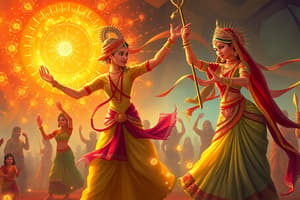Podcast
Questions and Answers
What ancient text is considered the most ancient and mentions music?
What ancient text is considered the most ancient and mentions music?
- Rigveda (correct)
- Yajurveda
- Samaveda
- Natyashastra
Which instrument is depicted as being held by Goddess Saraswati?
Which instrument is depicted as being held by Goddess Saraswati?
- Nadi
- Veena (correct)
- Dundubhi
- Bakura
How many strings did the ancient single-stringed veena have?
How many strings did the ancient single-stringed veena have?
- One (correct)
- Seven
- Nine
- Two
Which work by Bharatmuni describes various types of veenas?
Which work by Bharatmuni describes various types of veenas?
What were the three musical notes referred to during Vedic times?
What were the three musical notes referred to during Vedic times?
What does the term 'all-encompassing culture' mean in the context of the passage?
What does the term 'all-encompassing culture' mean in the context of the passage?
What unique feature of Indian markets does the passage highlight?
What unique feature of Indian markets does the passage highlight?
How does the author compare the modernity of Shivaji Raja with that of contemporary American innovations?
How does the author compare the modernity of Shivaji Raja with that of contemporary American innovations?
What was the author's initial reaction to the drive-in facilities in America as compared to the historical context shared about Raigad?
What was the author's initial reaction to the drive-in facilities in America as compared to the historical context shared about Raigad?
Which aspect of Indian culture does the author emphasize as a reason for its longevity?
Which aspect of Indian culture does the author emphasize as a reason for its longevity?
Flashcards are hidden until you start studying
Study Notes
Social Systems and Arts in Indian Knowledge Tradition
- Only an all-encompassing culture can withstand the test of time, considering all aspects of the human mind, including social factors.
- Indian culture fulfills this criterion, as articulated by Iqbal, who noted the enduring nature of Indian existence compared to Greece, Egypt, and Rome.
- The author's observations during travels illustrate a historical perspective on convenience in markets, contrasting modern drive-ins with ancient Indian innovations like horse-mounted market stalls.
Dance, Music, and Architectural Arts
- India's culture has a long-standing tradition of music and arts, deeply connected to spirituality and knowledge.
- Goddess Saraswati, the deity of music and learning, is often depicted with a veena, indicating the importance of this instrument in Indian culture.
- The SharadaAmba temple in Sringeri (9th century) and the temple in Gadag (11th century) emphasize the historical significance of Saraswati.
- Statues of Saraswati date back to the first century CE, showcasing the ancient roots of this artistic tradition and the veena's history of at least 4000 years.
Historical Context of Indian Music
- Bharatmuni’s 'Natyashastra' categorizes veenas into two main types: 'Chitra' (seven strings) and 'Vipanchi' (nine strings); it references other stringed instruments as well.
- Music's origins in India date back to the Vedic period, with the Rigveda (around 5000 years old) being the earliest reference to musical practice.
- The Yajurveda outlines the use of various musical instruments, suggesting that they were recognized as an art form by then.
- The 'Samaveda' is particularly focused on music, with notes known as 'Yama', indicating a structured approach to musical notation and performance during Vedic times.
Evolution of Musical Notes
- During Vedic times, singing with three notes (Ga, Re, Sa) formed the basis of music, which later expanded to seven notes.
- The concept of 'Sama' not only related to music but also was foundational in the development of musical theories and practices over time.
Studying That Suits You
Use AI to generate personalized quizzes and flashcards to suit your learning preferences.




